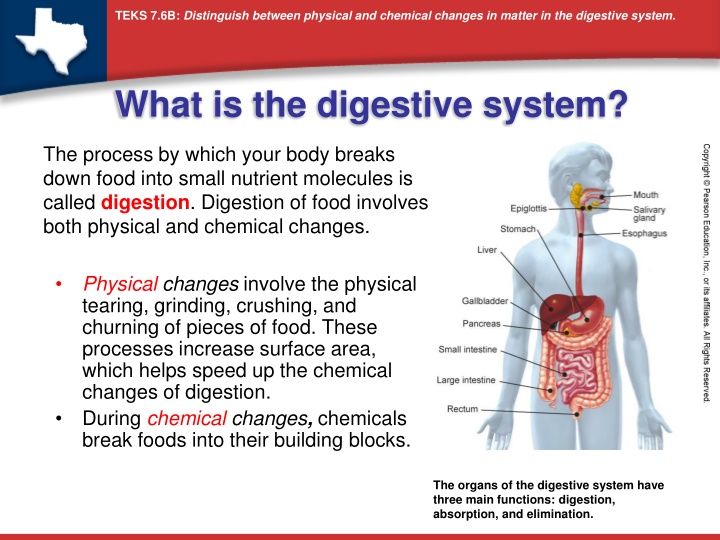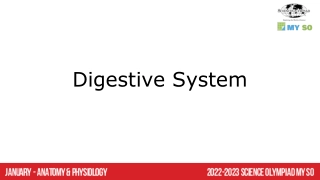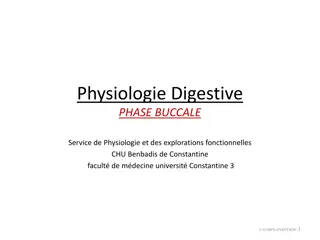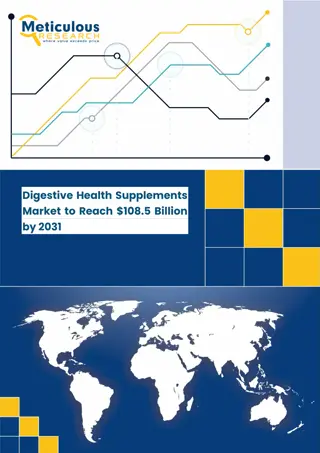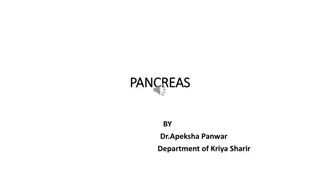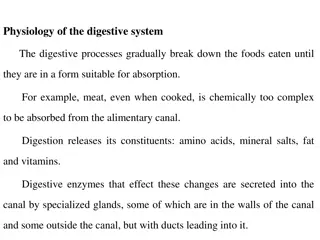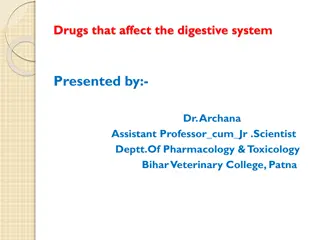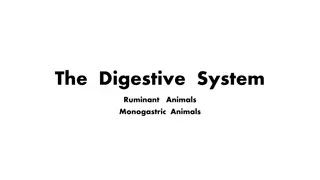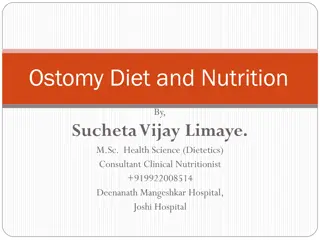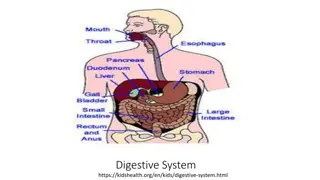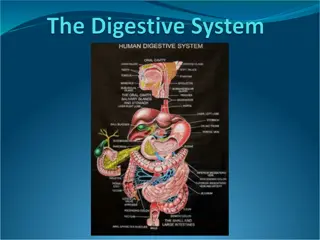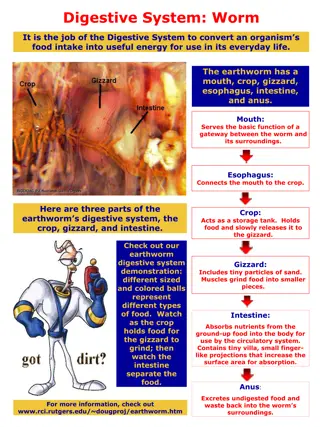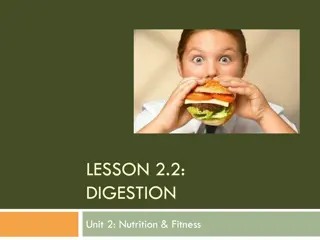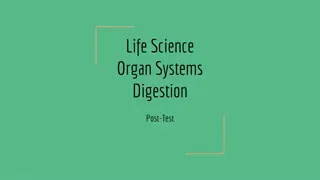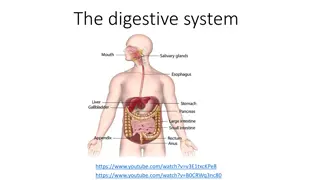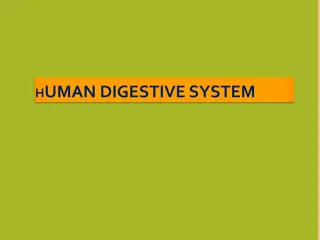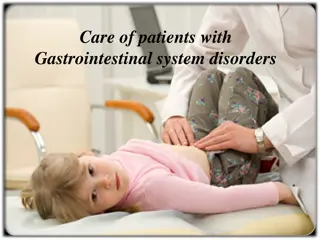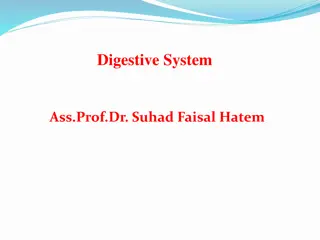What is the digestive system?
The digestive system processes food through physical and chemical changes. The mouth and stomach initiate these changes, involving enzymes, muscle contractions, and fluid mixing. The small intestine completes most of the chemical breakdown through enzymes released by glands. Understand the role of physical tearing, grinding, and chemical reactions in breaking down food for nutrient absorption.
Download Presentation

Please find below an Image/Link to download the presentation.
The content on the website is provided AS IS for your information and personal use only. It may not be sold, licensed, or shared on other websites without obtaining consent from the author.If you encounter any issues during the download, it is possible that the publisher has removed the file from their server.
You are allowed to download the files provided on this website for personal or commercial use, subject to the condition that they are used lawfully. All files are the property of their respective owners.
The content on the website is provided AS IS for your information and personal use only. It may not be sold, licensed, or shared on other websites without obtaining consent from the author.
E N D
Presentation Transcript
TEKS 7.6B: Distinguish between physical and chemical changes in matter in the digestive system. What is the digestive system? The process by which your body breaks down food into small nutrient molecules is called digestion. Digestion of food involves both physical and chemical changes. Physical changes involve the physical tearing, grinding, crushing, and churning of pieces of food. These processes increase surface area, which helps speed up the chemical changes of digestion. During chemical changes, chemicals break foods into their building blocks. The organs of the digestive system have three main functions: digestion, absorption, and elimination.
TEKS 7.6B: Distinguish between physical and chemical changes in matter in the digestive system. What changes occur in the mouth and stomach? Food enters your body through your mouth, where physical and chemical changes begin. Your teeth cut, tear, crush, and grind the food into small pieces. This is a physical change. Saliva in your mouth brings about two physical changes. Saliva moistens food, making it easier to swallow. It also dissolves some foods, such as salt. Saliva also brings about a chemical change. An enzyme in saliva begins the breakdown of starch into sugars. An enzyme is a protein that speeds up chemical reactions in your body. (contd.)
TEKS 7.6B: Distinguish between physical and chemical changes in matter in the digestive system. When you swallow, food enters the esophagus. Peristalsis, waves of involuntary muscle contractions, push food toward the stomach. There, more physical and chemical changes occur. Physical Changes Layers of smooth muscle in the stomach wall contract and produce a churning motion that mixes food with fluids in the stomach. Mucus in the fluids keeps the food moist and protects the stomach lining from other chemicals. Chemical Changes Gastric fluids also mix with the food. These fluids contain the enzyme pepsin, which breaks down proteins into short chains of amino acids. Hydrochloric acid provides the acid environment in which pepsin works best. It also helps kill many bacteria that you swallow with your food. 1. SummarizeWhat is the result of the chemical changes that occur in the mouth and stomach?
TEKS 7.6B: Distinguish between physical and chemical changes in matter in the digestive system. What changes occur in the small intestine? Most of the chemical changes of digestion take place in the small intestine. Starches and proteins that reach the small intestine are partly broken down by the time they reach the small intestine. Lipids are not. Substances produced by the liver, pancreas, and lining of the small intestine help to complete the chemical changes that turn carbohydrates, proteins, and lipids into small molecules. 2. InferAt 6 7 meters in length, the small intestine makes up two-thirds of the length of the digestive system. Its diameter is 2 3 cm. From this, infer what gives the small intestine its name. (contd.)
TEKS 7.6B: Distinguish between physical and chemical changes in matter in the digestive system. Glands in the small intestine release enzymes that help break down peptides into individual amino acids. Other glands produce enzymes that continue the digestion of complex sugars, producing the simple sugars the body uses for energy. The liver produces bile, which is stored in the gallbladder and released into the small intestine through a duct. There, bile physically breaks up large lipid particles into smaller droplets. Enzymes produced by the pancreas act on the droplets and chemically change them into smaller molecules. The pancreas also produces enzymes that help break down carbohydrates and proteins. After these chemical changes occur, the small nutrient molecules are absorbed through the surface of the small intestine into the blood. Villi, tiny finger-shaped structures, cover the wall of the intestine and increase its surface area. This allows more nutrients to be absorbed.
TEKS 7.6B: Distinguish between physical and chemical changes in matter in the digestive system. What changes occur in the large intestine? By the time material reaches the end of the small intestine, most nutrients have been absorbed. The water and undigested food that remain move into the large intestine. There, most of the water is absorbed into the bloodstream. The material that is left is readied for elimination from the body through the rectum. As wastes move through the 1.5-meter-long large intestine, bacteria feed on the material. These helpful bacteria make certain vitamins, including vitamin K. 3. RestateWhat physical changes occur as matter moves through the large intestine?
